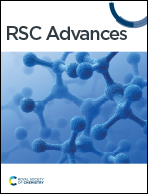Calcium hydroxide recycled from waste eggshell resources for the effective recovery of fluoride from wastewater†
Abstract
In the hunt of waste recovery pathways, eggshells emerged as a potential adsorbent for fluoride because they contain plenty of calcium. However, as the main component, calcite has weak interaction with fluoride. In this study, calcium hydroxide was derived from waste eggshells successfully by an aging treatment with moisture for fluoride recovery from water. The X-ray diffraction (XRD) and infrared spectroscopy (FT-IR) analyses indicate that CaO in calcined egg shells (AEG900) is completely converted to calcium hydroxide. The adsorption experiments showed that the adsorption capacity of AEG900 for fluoride was improved by nearly 29.21% compared with the calcined eggshells without the aging treatment. In the batch experiment, the temperature effect is the most significant for the adsorption process, and nearly a half increment of removal rate is achieved by increasing the temperature by 30 °C. Further research revealed that the adsorption process fitted well with the pseudo-second order model and the Langmuir–Freundlich isotherm model, with a maximum adsorption capacity of 370.15 mg g−1. Moreover, precipitation was regarded as the main step for fluoride removal mechanism based on the calculated results of the surface complexation model. X-ray photoelectron spectroscopy (XPS) results showed that the stable fluorite formed in situ of AEG900 avoids calcium loss in water. Finally, AEG900 was applied in fluoride removal with real-life groundwater and industrial wastewater, and the results showed that the final fluoride concentration could meet the WHO requirement and industrial wastewater discharge standard.



 Please wait while we load your content...
Please wait while we load your content...